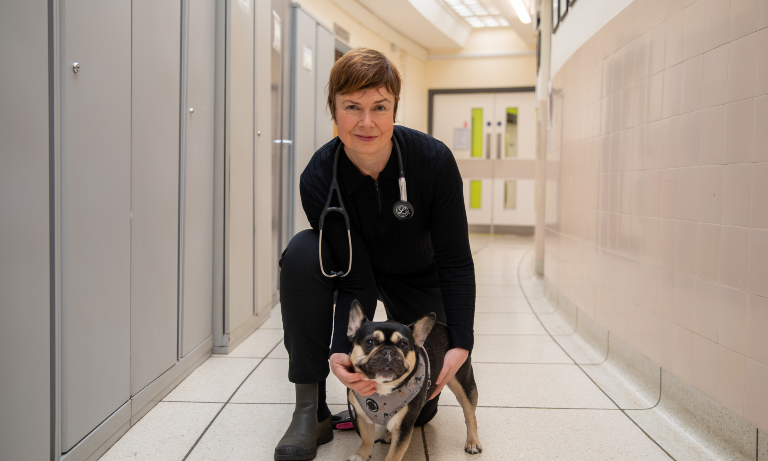The veterinary voice for animal welfare: reflecting on BVA’s updated Animal Welfare Strategy
11 Jul 2025
05 Jun 2025 | Jane Ladlow
Ahead of her BVA Live sessions on Brachycephalic Obstructive Airway Syndrome (BOAS), small animal surgery specialist Dr Jane Ladlow goes back over 20 years to the question that kickstarted her BOAS research journey and the lightbulb moment that led to the development of a practical and accessible airway function screening tool for vets.

Brachycephalic dogs – with their short muzzles and characteristic flat faces – have won the hearts of many. But behind the adorable snorts and wheezes often lies a more serious issue: brachycephalic obstructive airway syndrome (BOAS). At BVA Live next week, I’ll be diving into how we as a profession can better identify, communicate, and act on the early signs of BOAS. Here’s a preview of what I’ll be covering.
I first began researching BOAS back in 2003, during my time at the Animal Health Trust. It all began with a simple but troubling question: how successful is BOAS surgery really? I had encountered a case where I wasn’t convinced the surgical outcome had been beneficial, and I wanted to understand whether we were truly making a difference.
To answer that, we first had to measure airway function reliably in brachycephalic breeds. After experimenting with various techniques, I trialled whole body barometric plethysmography (WBBP) – affectionately known as the breathing chamber.
Not long after moving to Cambridge (while pregnant, no less), I was fortunate to be joined by an exceptionally talented student from Taiwan, Nah-Chieh, who wanted to pursue a Master’s. She stayed on, and the WBBP project became her PhD, giving me a dedicated partner to analyse the growing dataset – while I continued working full-time in clinical practice.
To build a robust and varied study population, we turned to dog breeders and attended dog shows, where we could assess 20–30 dogs in a single day. Nah-Chieh remained at Cambridge for 10 years, and together we explored a wide range of brachycephalic health questions, including external conformational risk factors and responses to surgery – both multilevel approaches and laser turbinectomy, the procedure that originally sparked this whole journey.
The plethysmography data was trained by our clinical assessments, which included an exercise test – a short three-minute run to stress the airway. This simple addition increased the sensitivity of BOAS diagnosis by 40%.
It was a lightbulb moment. I realised this could be developed into a practical and accessible screening tool usable by vets across the country. That led to a conversation with the Kennel Club, and in 2019, we launched the Respiratory Function Grading (RFG) Scheme - a simple, accessible tool that uses just a stethoscope and 15 minutes. It allows the vet to quickly assess airway function and open up meaningful discussions with owners.
Since then, we’ve trained assessors nationwide with the goal of ensuring local accessibility to this vital health screening. It was a real moment of satisfaction to see the RFG become the only mandatory health test for brachycephalic breeds at Crufts this year – a major milestone in improving breed welfare. For the first time, there was near silence around the French bulldog ring – a testament to the scheme’s impact. Even more heartening was the bulldog that took Best of Breed – a dog I remembered meeting three years ago. His breeder had responded directly to our research on conformation, and it showed: a longer neck, slimmer head, and open nostrils. It was a quiet victory for evidence-based breeding.
Interestingly, the only noticeably noisy pugs were those with a fatter body condition, underscoring how body condition score (BCS) directly influences airway function in this breed – a vital message for owners.
Looking to the Future
The Kennel Club is now analysing the heritability of BOAS using RFG data, and we expect those findings next year – a potentially game-changing step in health testing.
In the meantime, I’ve moved on from Cambridge and co-founded a new practice with colleagues Freddie Corlette, Jackie Demetriou, and Rob Foale – an exciting new chapter that takes up most of my time. However, I remain deeply involved in BOAS work, both as Chief Assessor for the RFG Scheme and in ongoing research.
Our current project? Investigating BOAS prevalence and severity in 14 additional brachycephalic breeds. Watch this space.
And the surgery? Does it work? Honest answer is usually yes, pretty well but it depends on lesion site and individual and measuring is really useful…
Get tailored news in your inbox and online, plus access to our journals, resources and support services, join the BVA.
Join Us Today